BMW X5 4.8IS 2006 E53 Owner's Manual
Manufacturer: BMW, Model Year: 2006, Model line: X5 4.8IS, Model: BMW X5 4.8IS 2006 E53Pages: 202, PDF Size: 4.13 MB
Page 141 of 202
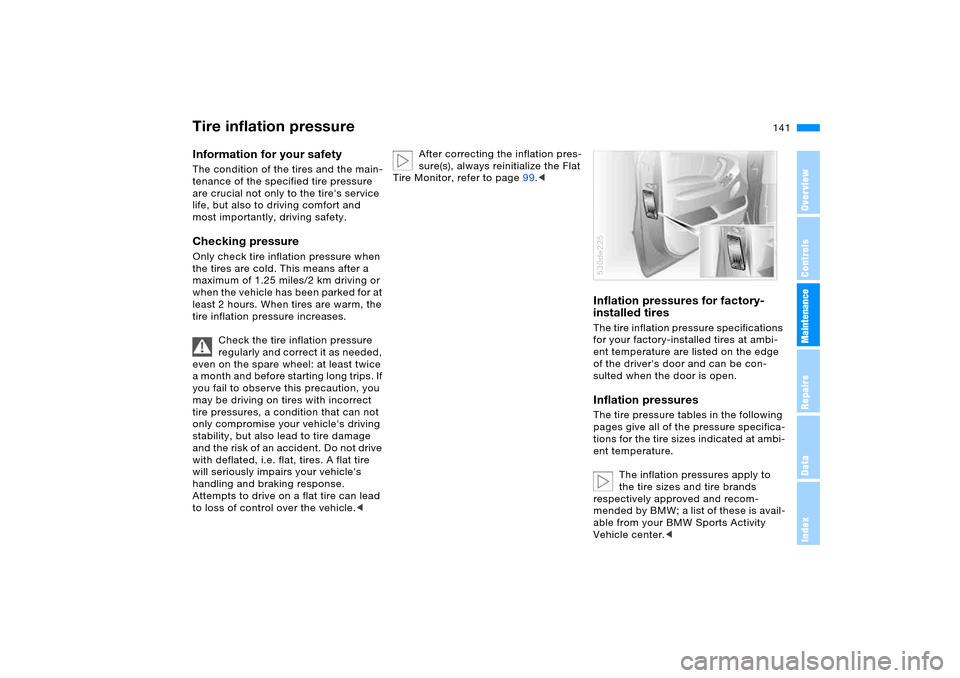
141n
OverviewControlsMaintenanceRepairsDataIndex
Information for your safety The condition of the tires and the main-
tenance of the specified tire pressure
are crucial not only to the tire's service
life, but also to driving comfort and
most importantly, driving safety. Checking pressureOnly check tire inflation pressure when
the tires are cold. This means after a
maximum of 1.25 miles/2 km driving or
when the vehicle has been parked for at
least 2 hours. When tires are warm, the
tire inflation pressure increases.
Check the tire inflation pressure
regularly and correct it as needed,
even on the spare wheel: at least twice
a month and before starting long trips. If
you fail to observe this precaution, you
may be driving on tires with incorrect
tire pressures, a condition that can not
only compromise your vehicle's driving
stability, but also lead to tire damage
and the risk of an accident. Do not drive
with deflated, i.e. flat, tires. A flat tire
will seriously impairs your vehicle's
handling and braking response.
Attempts to drive on a flat tire can lead
to loss of control over the vehicle.<
After correcting the inflation pres-
sure(s), always reinitialize the Flat
Tire Monitor, refer to page99.<
Inflation pressures for factory-
installed tiresThe tire inflation pressure specifications
for your factory-installed tires at ambi-
ent temperature are listed on the edge
of the driver's door and can be con-
sulted when the door is open.Inflation pressuresThe tire pressure tables in the following
pages give all of the pressure specifica-
tions for the tire sizes indicated at ambi-
ent temperature.
The inflation pressures apply to
the tire sizes and tire brands
respectively approved and recom-
mended by BMW; a list of these is avail-
able from your BMW Sports Activity
Vehicle center.<530de225
Tire inflation pressure
Page 142 of 202
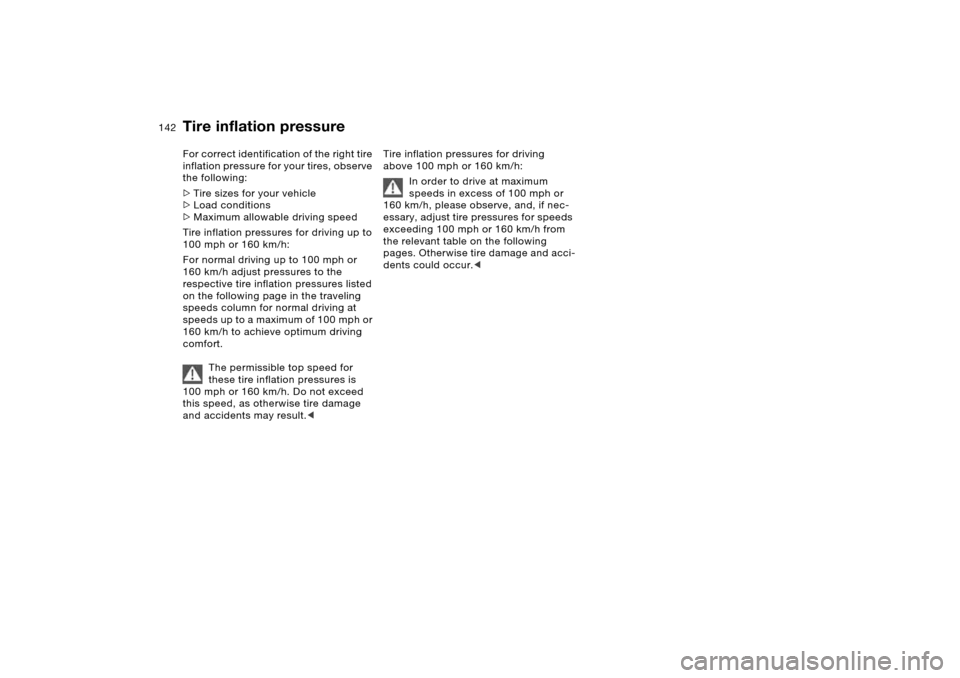
142n
Tire inflation pressureFor correct identification of the right tire
inflation pressure for your tires, observe
the following:
>Tire sizes for your vehicle
>Load conditions
>Maximum allowable driving speed
Tire inflation pressures for driving up to
100mph or 160km/h:
For normal driving up to 100 mph or
160 km/h adjust pressures to the
respective tire inflation pressures listed
on the following page in the traveling
speeds column for normal driving at
spe eds up to a m axim um o f 10 0 m p h or
160 km/h to achieve optimum driving
comfort.
The permissible top speed for
these tire inflation pressures is
100mph or 160km/h. Do not exceed
this speed, as otherwise tire damage
and accidents may result.<
Tire inflation pressures for driving
above 100 mph or 160 km/h:
In order to drive at maximum
speeds in excess of 100 mph or
160 km/h, please observe, and, if nec-
essary, adjust tire pressures for speeds
exceeding 100 mph or 160 km/h from
the relevant table on the following
pages. Otherwise tire damage and acci-
dents could occur.<
Page 143 of 202
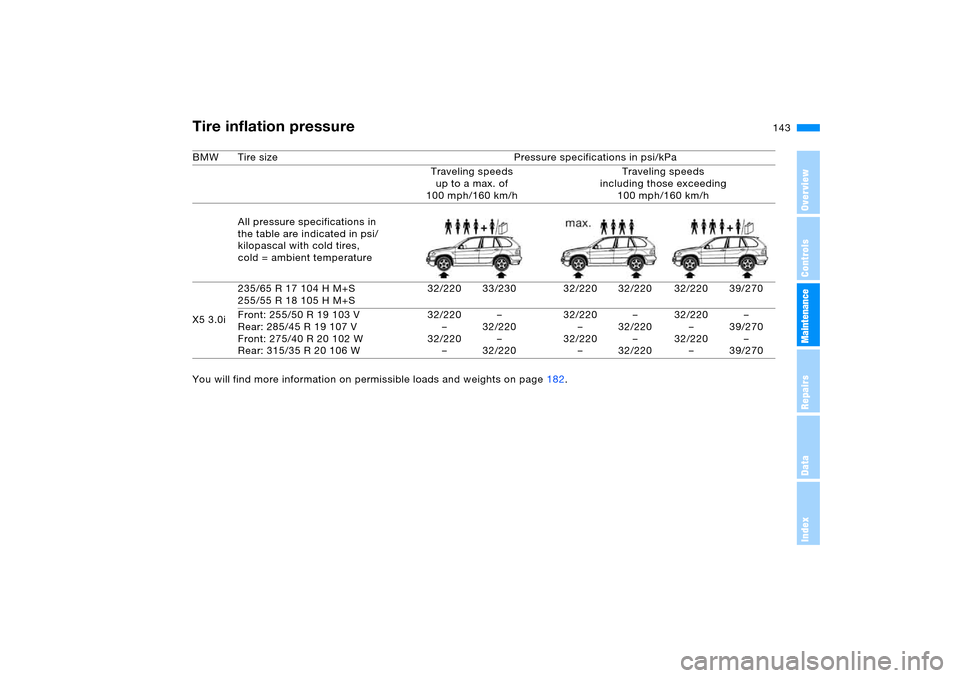
143n
OverviewControlsMaintenanceRepairsDataIndex
Tire inflation pressureBMW Tire size Pressure specifications in psi/kPa
Traveling speeds
up to a max. of
100 mph/160 km/hTraveling speeds
including those exceeding
100 mph/160 km/h
All pressure specifications in
the table are indicated in psi/
kilopascal with cold tires,
cold = ambient temperature
X5 3.0i235/65 R 17 104 H M+S
255/55 R 18 105 H M+S32/220 33/230 32/220 32/220 32/220 39/270
Front: 255/50 R 19 103 V
Rear: 285/45 R 19 107 V
Front: 275/40 R 20 102 W
Rear: 315/35 R 20 106 W32/220
–
32/220
––
32/220
–
32/22032/220
–
32/220
––
32/220
–
32/22032/220
–
32/220
––
39/270
–
39/270
You will find more information on permissible loads and weights on page182.
Page 144 of 202
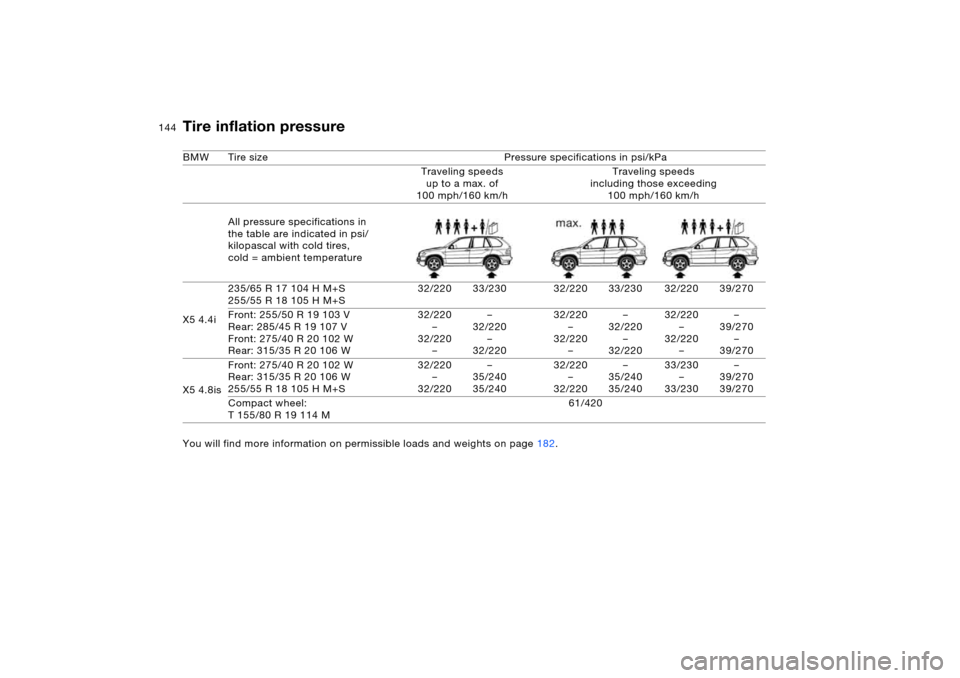
144n
Tire inflation pressureBMW Tire size Pressure specifications in psi/kPa
Traveling speeds
up to a max. of
100 mph/160 km/hTraveling speeds
including those exceeding
100 mph/160 km/h
All pressure specifications in
the table are indicated in psi/
kilopascal with cold tires,
cold = ambient temperature
X5 4.4i235/65 R 17 104 H M+S
255/55 R 18 105 H M+S32/220 33/230 32/220 33/230 32/220 39/270
Front: 255/50 R 19 103 V
Rear: 285/45 R 19 107 V
Front: 275/40 R 20 102 W
Rear: 315/35 R 20 106 W32/220
–
32/220
––
32/220
–
32/22032/220
–
32/220
––
32/220
–
32/22032/220
–
32/220
––
39/270
–
39/270
X5 4.8isFront: 275/40 R 20 102 W
Rear: 315/35 R 20 106 W
255/55 R 18 105 H M+S32/220
–
32/220–
35/240
35/24032/220
–
32/220–
35/240
35/24033/230
–
33/230–
39/270
39/270
Compact wheel:
T 155/80 R 19 114 M61/420
You will find more information on permissible loads and weights on page182.
Page 145 of 202
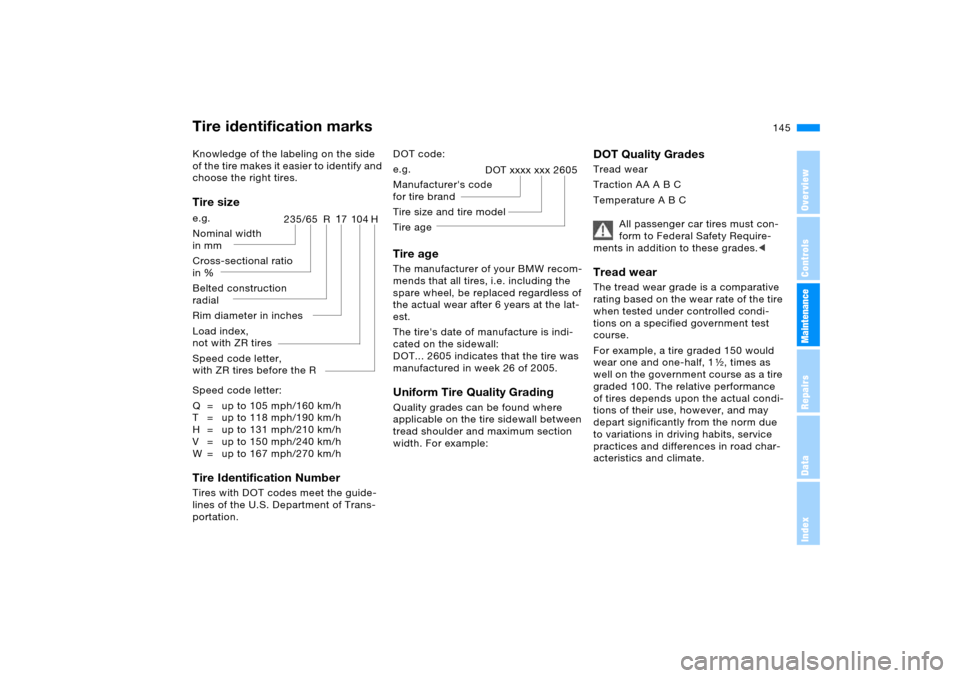
145n
OverviewControlsMaintenanceRepairsDataIndex
Tire identification marksKnowledge of the labeling on the side
of the tire makes it easier to identify and
choose the right tires.Tire sizeSpeed code letter:
Q = up to 105 mph/160 km/h
T = up to 118 mph/190 km/h
H = up to 131 mph/210 km/h
V = up to 150 mph/240 km/h
W = up to 167 mph/270 km/hTire Identification Number Tires with DOT codes meet the guide-
lines of the U.S. Department of Trans-
portation. e.g.
Nominal width
in mm
Cross-sectional ratio
in Ξ
Belted construction
radial
Rim diameter in inches
Load index,
not with ZR tires
Speed code letter,
with ZR tires before the R
235/65 R
17104H
DOT code: Tire age The manufacturer of your BMW recom-
mends that all tires, i.e. including the
spare wheel, be replaced regardless of
the actual wear after 6 years at the lat-
est.
The tire's date of manufacture is indi-
cated on the sidewall:
DOT... 2605 indicates that the tire was
manufactured in week 26 of 2005. Uniform Tire Quality Grading Quality grades can be found where
applicable on the tire sidewall between
tread shoulder and maximum section
width. For example: e.g.
Manufacturer's code
for tire brand
Tire size and tire model
Tire age
DOT xxxx xxx 2605
DOT Quality Grades Tread wear
Traction AA A B C
Temperature A B C
All passenger car tires must con-
form to Federal Safety Require-
ments in addition to these grades.< Tread wear The tread wear grade is a comparative
rating based on the wear rate of the tire
when tested under controlled condi-
tions on a specified government test
course.
For example, a tire graded 150 would
wear one and one-half, 1γ, times as
well on the government course as a tire
graded 100. The relative performance
of tires depends upon the actual condi-
tions of their use, however, and may
depart significantly from the norm due
to variations in driving habits, service
practices and differences in road char-
acteristics and climate.
Page 146 of 202
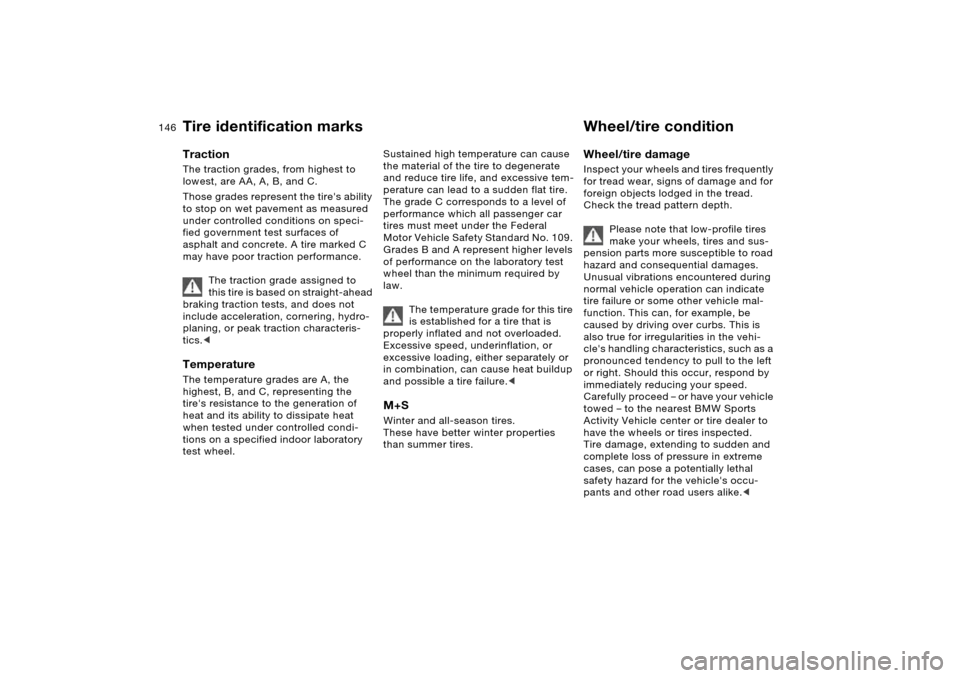
146n
Tire identification marks Wheel/tire condition Traction The traction grades, from highest to
lowest, are AA, A, B, and C.
Those grades represent the tire's ability
to stop on wet pavement as measured
under controlled conditions on speci-
fied government test surfaces of
asphalt and concrete. A tire marked C
may have poor traction performance.
The traction grade assigned to
this tire is based on straight-ahead
braking traction tests, and does not
include acceleration, cornering, hydro-
planing, or peak traction characteris-
tics.< TemperatureThe temperature grades are A, the
highest, B, and C, representing the
tire's resistance to the generation of
heat and its ability to dissipate heat
when tested under controlled condi-
tions on a specified indoor laboratory
test wheel.
Sustained high temperature can cause
the material of the tire to degenerate
and reduce tire life, and excessive tem-
perature can lead to a sudden flat tire.
The grade C corresponds to a level of
performance which all passenger car
tires must meet under the Federal
Motor Vehicle Safety Standard No. 109.
Grades B and A represent higher levels
of performance on the laboratory test
wheel than the minimum required by
law.
The temperature grade for this tire
is established for a tire that is
properly inflated and not overloaded.
Excessive speed, underinflation, or
excessive loading, either separately or
in combination, can cause heat buildup
and possible a tire failure.< M+SWinter and all-season tires.
These have better winter properties
than summer tires.
Wheel/tire damage Inspect your wheels and tires frequently
for tread wear, signs of damage and for
foreign objects lodged in the tread.
Check the tread pattern depth.
Please note that low-profile tires
make your wheels, tires and sus-
pension parts more susceptible to road
hazard and consequential damages.
Unusual vibrations encountered during
normal vehicle operation can indicate
tire failure or some other vehicle mal-
function. This can, for example, be
caused by driving over curbs. This is
also true for irregularities in the vehi-
cle's handling characteristics, such as a
pronounced tendency to pull to the left
or right. Should this occur, respond by
immediately reducing your speed.
Carefully proceed – or have your vehicle
towed – to the nearest BMW Sports
Activity Vehicle center or tire dealer to
have the wheels or tires inspected.
Tire damage, extending to sudden and
complete loss of pressure in extreme
cases, can pose a potentially lethal
safety hazard for the vehicle's occu-
pants and other road users alike.<
Page 147 of 202
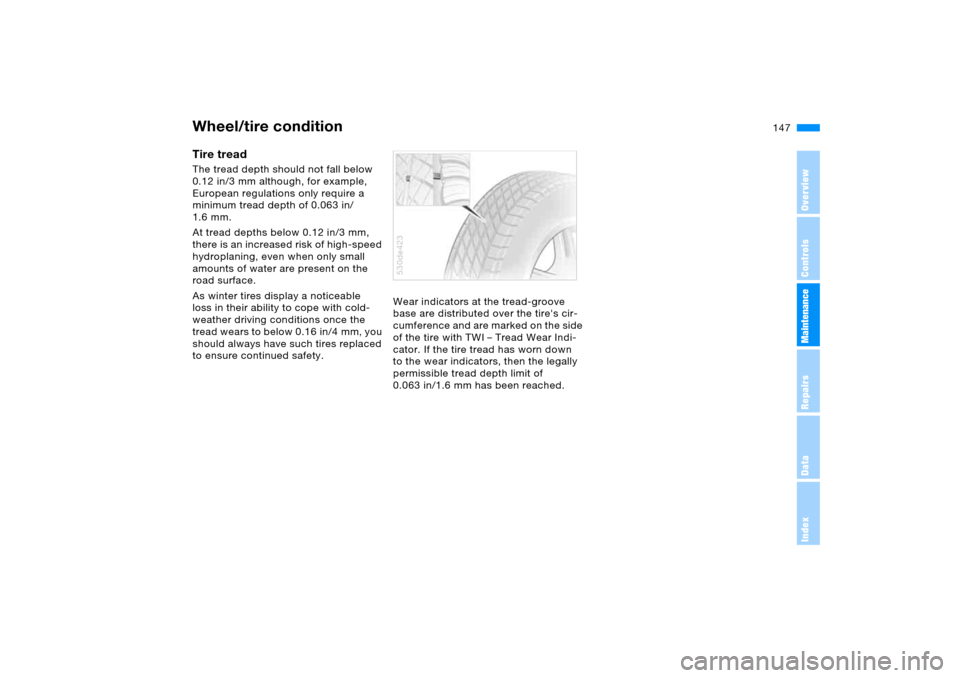
147n
OverviewControlsMaintenanceRepairsDataIndex
Wheel/tire conditionTire tread The tread depth should not fall below
0.12 in/3 mm although, for example,
European regulations only require a
minimum tread depth of 0.063 in/
1.6 mm.
At tread depths below 0.12 in/3 mm,
there is an increased risk of high-speed
hydroplaning, even when only small
amounts of water are present on the
road surface.
As winter tires display a noticeable
loss in their ability to cope with cold-
weather driving conditions once the
tread wears to below 0.16 in/4 mm, you
should always have such tires replaced
to ensure continued safety.Wear indicators at the tread-groove
base are distributed over the tire's cir-
cumference and are marked on the side
of the tire with TWI – Tread Wear Indi-
cator. If the tire tread has worn down
to the wear indicators, then the legally
permissible tread depth limit of
0.063 in/1.6 mm has been reached.
530de423
Page 148 of 202
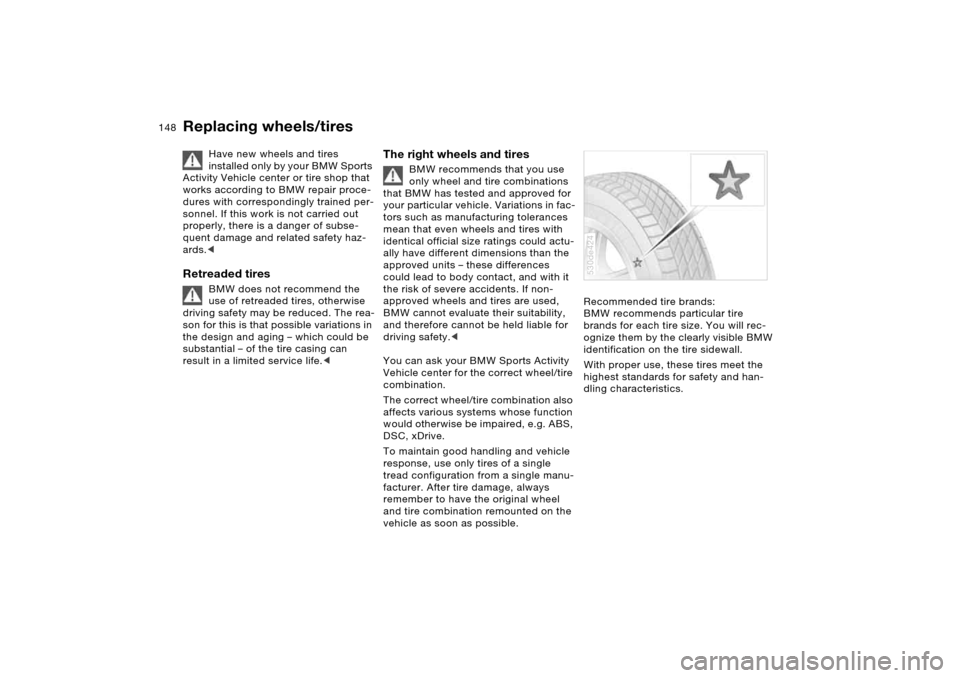
148n
Replacing wheels/tires
Have new wheels and tires
installed only by your BMW Sports
Activity Vehicle center or tire shop that
works according to BMW repair proce-
dures with correspondingly trained per-
sonnel. If this work is not carried out
properly, there is a danger of subse-
quent damage and related safety haz-
ards.<
Retreaded tires
BMW does not recommend the
use of retreaded tires, otherwise
driving safety may be reduced. The rea-
son for this is that possible variations in
the design and aging – which could be
substantial – of the tire casing can
result in a limited service life.<
The right wheels and tires
BMW recommends that you use
only wheel and tire combinations
that BMW has tested and approved for
your particular vehicle. Variations in fac-
tors such as manufacturing tolerances
mean that even wheels and tires with
identical official size ratings could actu-
ally have different dimensions than the
approved units – these differences
could lead to body contact, and with it
the risk of severe accidents. If non-
approved wheels and tires are used,
BMW cannot evaluate their suitability,
and therefore cannot be held liable for
driving safety.<
You can ask your BMW Sports Activity
Vehicle center for the correct wheel/tire
combination.
The correct wheel/tire combination also
affects various systems whose function
would otherwise be impaired, e.g. ABS,
DSC, xDrive.
To maintain good handling and vehicle
response, use only tires of a single
tread configuration from a single manu-
facturer. After tire damage, always
remember to have the original wheel
and tire combination remounted on the
vehicle as soon as possible.
Recommended tire brands:
BMW recommends particular tire
brands for each tire size. You will rec-
ognize them by the clearly visible BMW
identification on the tire sidewall.
With proper use, these tires meet the
highest standards for safety and han-
dling characteristics.530de424
Page 149 of 202
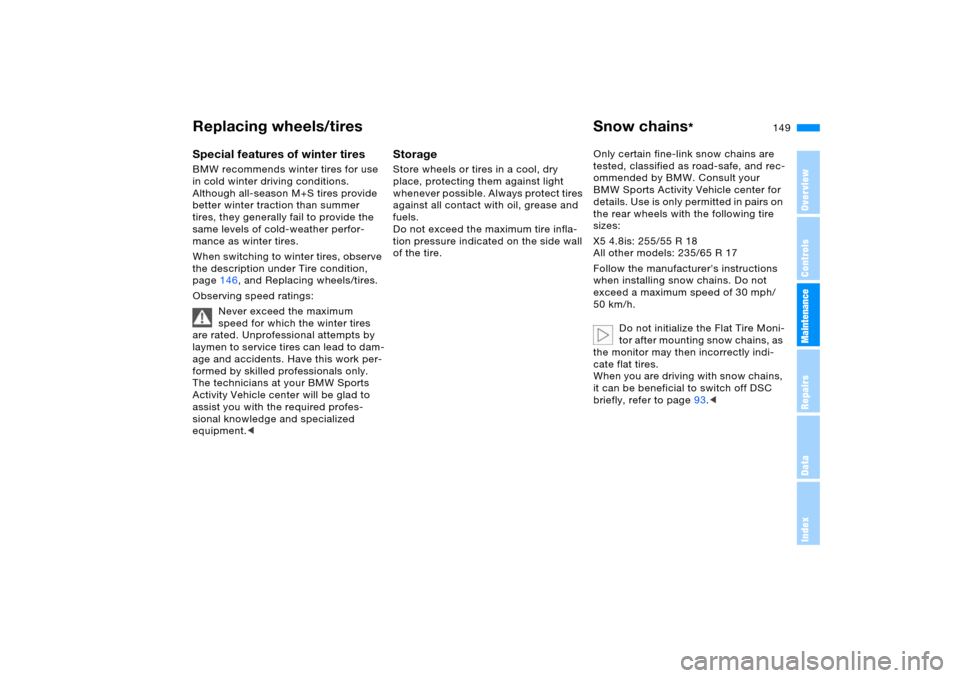
149n
OverviewControlsMaintenanceRepairsDataIndex
Replacing wheels/tires Snow chains
*
Special features of winter tires BMW recommends winter tires for use
in cold winter driving conditions.
Although all-season M+S tires provide
better winter traction than summer
tires, they generally fail to provide the
same levels of cold-weather perfor-
mance as winter tires.
When switching to winter tires, observe
the description under Tire condition,
page146, and Replacing wheels/tires.
Observing speed ratings:
Never exceed the maximum
speed for which the winter tires
are rated. Unprofessional attempts by
laymen to service tires can lead to dam-
age and accidents. Have this work per-
formed by skilled professionals only.
The technicians at your BMW Sports
Activity Vehicle center will be glad to
assist you with the required profes-
sional knowledge and specialized
equipment.<
Storage Store wheels or tires in a cool, dry
place, protecting them against light
whenever possible. Always protect tires
against all contact with oil, grease and
fuels.
Do not exceed the maximum tire infla-
tion pressure indicated on the side wall
of the tire.Only certain fine-link snow chains are
tested, classified as road-safe, and rec-
ommended by BMW. Consult your
BMW Sports Activity Vehicle center for
details. Use is only permitted in pairs on
the rear wheels with the following tire
sizes:
X5 4.8is: 255/55 R 18
All other models: 235/65 R 17
Follow the manufacturer's instructions
when installing snow chains. Do not
exceed a maximum speed of 30 mph/
50 km/h.
Do not initialize the Flat Tire Moni-
tor after mounting snow chains, as
the monitor may then incorrectly indi-
cate flat tires.
When you are driving with snow chains,
it can be beneficial to switch off DSC
briefly, refer to page93.<
Page 150 of 202
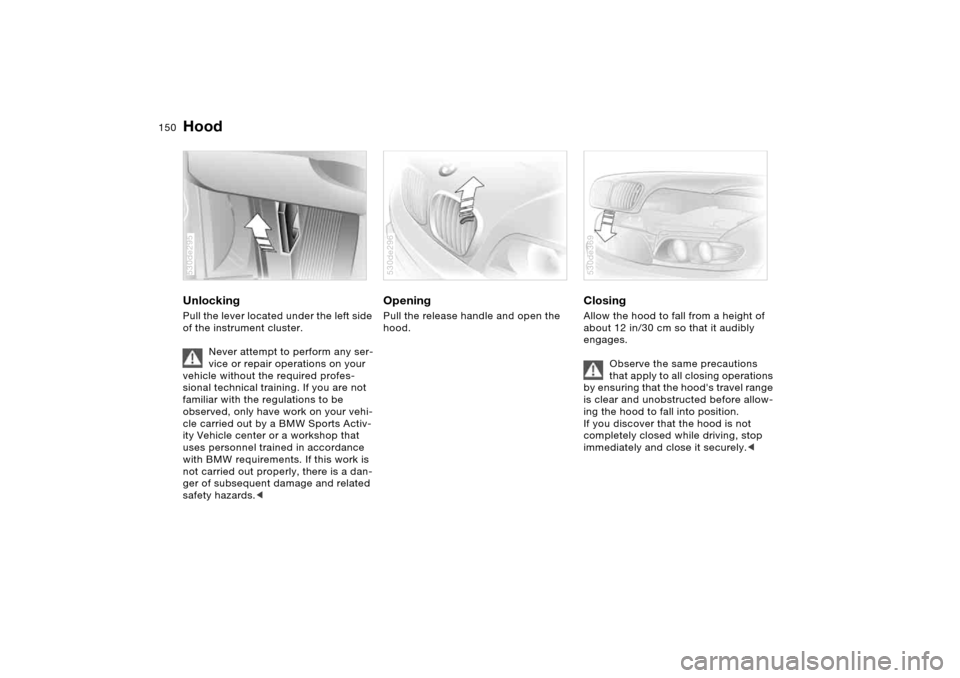
150n
Hood Unlocking Pull the lever located under the left side
of the instrument cluster.
Never attempt to perform any ser-
vice or repair operations on your
vehicle without the required profes-
sional technical training. If you are not
familiar with the regulations to be
observed, only have work on your vehi-
cle carried out by a BMW Sports Activ-
ity Vehicle center or a workshop that
uses personnel trained in accordance
with BMW requirements. If this work is
not carried out properly, there is a dan-
ger of subsequent damage and related
safety hazards.< 530de295
Opening Pull the release handle and open the
hood. 530de296
Closing Allow the hood to fall from a height of
about 12 in/30 cm so that it audibly
engages.
Observe the same precautions
that apply to all closing operations
by ensuring that the hood's travel range
is clear and unobstructed before allow-
ing the hood to fall into position.
If you discover that the hood is not
completely closed while driving, stop
immediately and close it securely.< 530de369